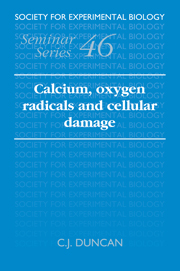Book contents
- Frontmatter
- Contents
- List of Contributors
- Preface
- 1 Are there common biochemical pathways in cell damage and cell death?
- 2 Free radicals in the pathogenesis of tissue damage
- 3 Calcium and signal transduction in oxidative cell damage
- 4 Regulation of neutrophil oxidant production
- 5 Reperfusion arrhythmias: role of oxidant stress
- 6 Biochemical pathways that lead to the release of cytosolic proteins in the perfused rat heart
- 7 Malignant hyperthermia: the roles of free radicals and calcium?
- 8 Free radicals, calcium and damage in dystrophic and normal skeletal muscle
- 9 Ultrastructural changes in mitochondria during rapid damage triggered by calcium
- 10 The importance of oxygen free radicals, iron and calcium in renal ischaemia
- 11 The Rubicon Hypothesis: a quantal framework for understanding the molecular pathway of cell activation and injury
- Index
5 - Reperfusion arrhythmias: role of oxidant stress
Published online by Cambridge University Press: 18 January 2010
- Frontmatter
- Contents
- List of Contributors
- Preface
- 1 Are there common biochemical pathways in cell damage and cell death?
- 2 Free radicals in the pathogenesis of tissue damage
- 3 Calcium and signal transduction in oxidative cell damage
- 4 Regulation of neutrophil oxidant production
- 5 Reperfusion arrhythmias: role of oxidant stress
- 6 Biochemical pathways that lead to the release of cytosolic proteins in the perfused rat heart
- 7 Malignant hyperthermia: the roles of free radicals and calcium?
- 8 Free radicals, calcium and damage in dystrophic and normal skeletal muscle
- 9 Ultrastructural changes in mitochondria during rapid damage triggered by calcium
- 10 The importance of oxygen free radicals, iron and calcium in renal ischaemia
- 11 The Rubicon Hypothesis: a quantal framework for understanding the molecular pathway of cell activation and injury
- Index
Summary
Introduction
Reperfusion of the ischaemic myocardium
The occlusion of a coronary artery leads to the development of myocardial ischaemia and initiates the process of infarction. It is clear that the readmission of blood to severely ischaemic tissue is essential if that tissue is ultimately to survive. Clinically, reperfusion can be achieved within hours of the onset of an ischaemic episode (using angioplasty and thrombolytic techniques), following prolonged ischaemia (using coronary artery bypass grafts) or may occur spontaneously following coronary artery spasm. The recent development of safe angioplasty techniques and effective thrombolytic drugs has led to an increased interest in the consequences of reperfusion. Although clinically such interventions can preserve myocardial function and improve prognosis (Serruys et al., 1986), there is a growing body of evidence from animal models to suggest that reperfusion can, in itself, promote a variety of undesirable effects such as arrhythmias (Manning & Hearse, 1984), myocardial stunning (Braunwald & Kloner, 1982), and leucocyte infiltration and vasoconstriction (Engler et al., 1986).
The concept that reperfusion of reversibly damaged but viable cells can promote lethal injury in that tissue is, however, controversial (Hearse, 1989; 1991; Opie, 1989). Although there is considerable experimental evidence implying that reperfusion may accelerate the expression of injury in cells that are ultimately destined to die, conclusive evidence that reperfusion itself can kill viable cells does not yet exist. The acceleration of tissue injury by reperfusion may, however, alter the processes underlying cell death and may therefore lead to differences in scar formation, leucocyte infiltration and susceptibility to aneurism. There is considerable evidence in support of the existence of this type of reperfusion-induced injury.
- Type
- Chapter
- Information
- Calcium, Oxygen Radicals and Cellular Damage , pp. 77 - 96Publisher: Cambridge University PressPrint publication year: 1991



